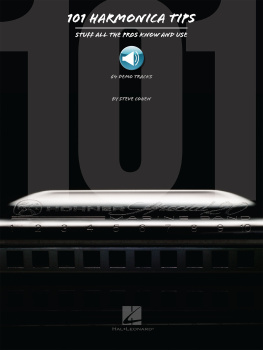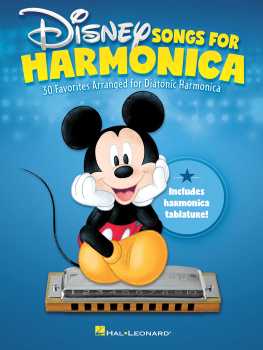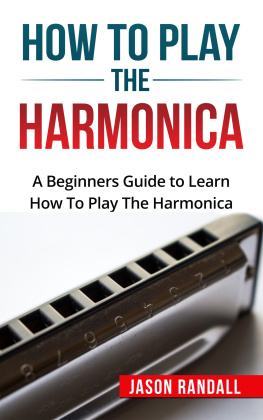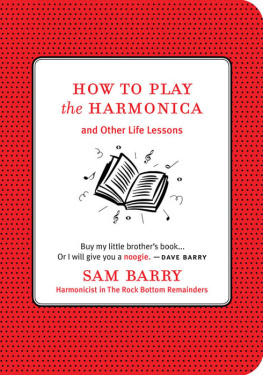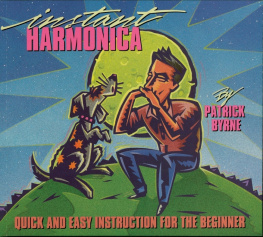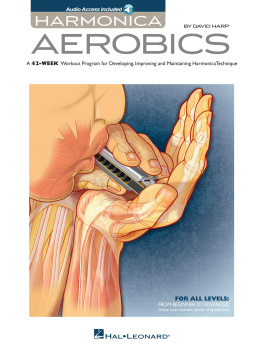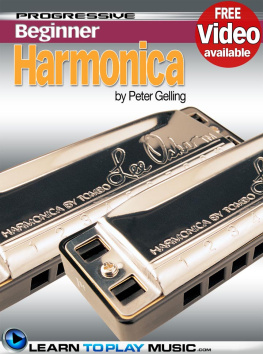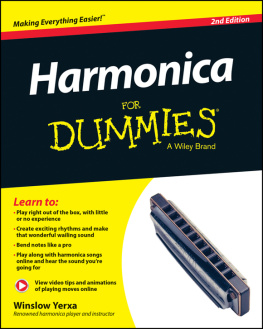
7777 W. Bluemound Rd. P.O. Box 13819 Milwaukee, WI 53213
In Australia Contact:
Hal Leonard Australia Pty. Ltd.
4 Lentara Court
Cheltenham, Victoria, 3192 Australia
Copyright 2011 by HAL LEONARD CORPORATION
International Copyright Secured All Rights Reserved
No part of this publication may be reproduced in any form or by any means without the prior written permission of the Publisher.
Visit Hal Leonard Online at
www.halleonard.com
Contents
introduction
The 10-hole diatonic harmonica is a unique instrument. Capable of limitless expression, it is usuallylearned by ear. This book will help you learn to start playing or improve your playing using a by-earmethod, as well as with musical notation and tablature. Also included is practical information relatingto performance, maintenance, and the wide world of harmonicas.
Steve Cohen, based in Milwaukee, Wisconsin, is a performingmusician, a professional educator, and a booking agent.He has been sponsored by Hohner Inc., the worlds largestmaker of harmonicas, since 1986. He also plays the guitarand sings. Steve performs regularly in several of his ownensembles, averaging more than 100 personal appearancesa year and is in demand as a sideman for both local andnational groups. He has produced eight published recordingsof his own, and his playing has appeared on dozens of otherrecordings, demos, and commercials as a session player.
Steve has received public recognition, winning over a dozenawards from several organizations, including the WisconsinArea Music Industry (WAMI), the Shepherd Express ReadersPoll, and Milwaukee Magazine. He was a finalist at the2010 International Blues Challenge in Memphis as a soloperformer.
Steve taught a blues history course at the University ofWisconsin, Milwaukee from 20052009. He has also taughtharmonica and guitar to many private students. His BluesCentral booking agency, the only one in his area devoted toblues and other forms of non-commercial music, has been inoperation since the early 1980s. In his thirty-plus year career,other music-related activities have included work as a discjockey, journalist, concert promoter, and LP and CD dealer.
Steve has also recorded the harmonica parts for numerousHal Leonard Harmonica Play-Along book/CDs, as well as avariety of other Hal Leonard products.
Visit Steve online at www.stevecohenblues.com
tips 1 17 : harmonica basics
1
choosing a model
and brand
There are at least a dozen manufacturers offering a wide variety of models of 10-hole diatonicharmonicas. Hohner is still among the most popular brands. If you buy a Hohner to start, Id recommenda Marine Band, Special 20, or Golden Melody. These models are of professional quality.Some of the other brands that make good harps are Lee Oskar, Hering, Huang, and Sydell.
2
There are now craftsmen who make high-quality, custom harps. These harps can be built and setup for your particular needs. Spearheading the movement is Joe Filisko of Joliet, Illinois, but thereare several other skilled builders. I use my set of Filisko harps sparingly, usually just for recording orspecial occasions. They play more easily and sound better than stock harps.
3
There are twelve keys, and diatonic harmonicas are manufactured in all twelve. The lowest-pitchedstock harp is G, and the highest is F A . The C harp is pitched in the middle, and if youre starting withone harmonica, C would be a good choice, as it is the most neutral. All demo tracks accompanyingthis book will be played on a C harp. Some manufacturers make harps that are tuned extra high, extralow, or with alternate tunings. Low D, low F, and high G are among the most useful of these.
4
wood vs. plastic/metal combs
Harmonicas are constructed with a comb in the center, a reed plate on each side of it, and coverson the top and bottom. Combs can be made of different materials. These materials give the instrumentcharacteristics that partially dictate how they sound and play.
Harps with wood combs can swell when they get excess saliva in them. When the wood swells, theteeth in the comb can stick out and create a hazard to your lips. The teeth usually shrink back down,but they dont always go back down all the way, or can shrink too far into the harmonica. Excesssaliva is more often a problem for beginners than for more experienced players. Many great playersswear by wood-combed models.
Harps with plastic or metal combs dont swell.Wood combs are thought to produce a moremellow tone than harps with plastic or metalcombs, and some players prefer wood-combedharps for the tonal quality. The difference issubtle, especially if you are playing with distortionthrough an amplifier. Different makes andmodels sound and play differently.
Other differences between makes and modelsconcern the size of the holes, the size andshape of the reed plate covers, and the easewith which one can repair them. Some harpshave replaceable reed plates, while others havereplaceable reeds. There are many options anda wide price range, soaring to hundreds of dollarsper harp. It is best to try different modelsand get a feel for which is best for you.
5
Find a comfortable way to hold your harmonica. With the numbers facing up, put it in the crook ofyour left hand between your index finger and your thumb. Put your thumb straight up at a right angleto the harp so that the back of your thumb touches the front of the harp without blocking the firsthole. Do the same with your right hand, trying not to block the 10 hole, and then fold your handsaround the back of the instrument until they meet and create a seal. This forms a little cup of airbetween the harp and the back of your hands.
Posture is important. If you are sitting, sit up straight. If you are standing, stand up straight. Your abilityto maximize your breathing is what powers the notes. Breathe deeply, from your diaphragm.
6
Rest the bottom of the harp on the inside of your lower lip, and then close your lips around it. Your lips should be firm but relaxed enough for the harp to slide. The same goes for the way your hands hold the harpfirm, but not in a death grip. Hold the harp parallel to the ground, not at an angle. The harmonica should sit as deep in your mouth as is comfortable. Be sure that none of the air going through the harmonica is leaking where the instrument meets your mouth. If you are getting weak notes or can hear air leaking, adjust how the harp meets your mouth.

